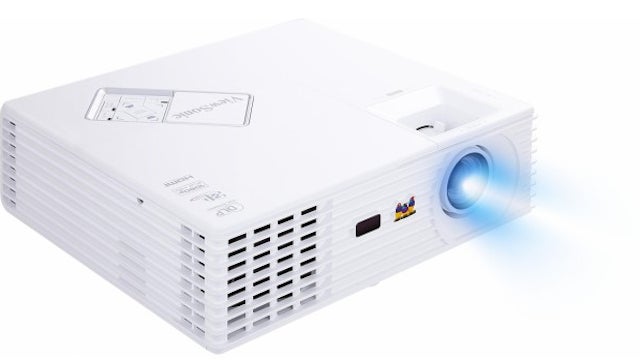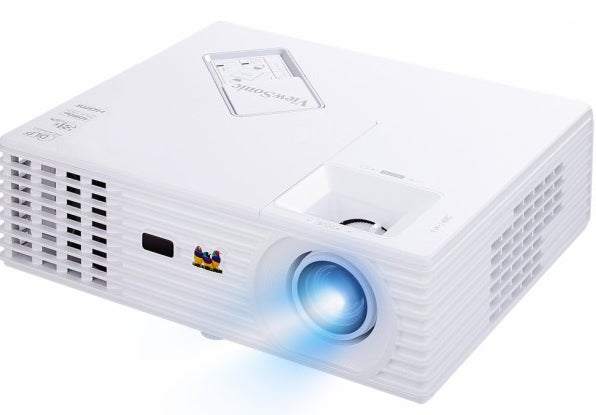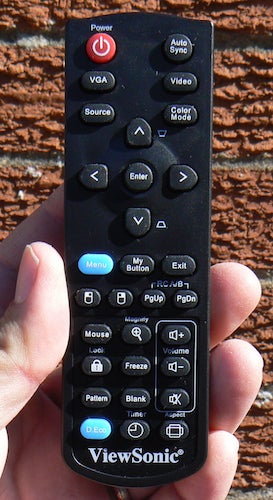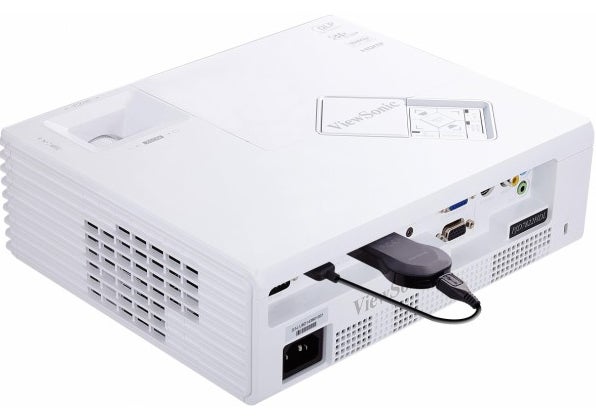ViewSonic PJD7822HDL Review - Picture Quality, Sound and Verdict Review
Picture Quality, Sound and Verdict
A great budget projector for bright rooms, but too flawed for serious movie fans

Sections
- Page 1 ViewSonic PJD7822HDL Review
- Page 2 Picture Quality, Sound and Verdict Review
ViewSonic PJD7822HDL – Picture Quality
The PJD7822HDL’s pictures are ultimately frustrating, as a single major flaw consistently undermines a lot of good work.
This good work kicks off with impressive clarity. The full HD native resolution helps HD sources look cleaner and more detailed than the 720p projectors often found below £600, and ViewSonic has done a good job of suppressing the sort of fizzing, dotting noise problems that can be associated with cheap single-chip DLP technology.
The clarity is boosted, too, by the quality of the PJD7822HDL’s motion handling. Even very rapid motion and speedy camera pans are handled with good clarity and fluidity, free of significant judder or blurring. This is achieved without using any processing either, so you don’t have to worry about such processing artefacts as distorted haloes around moving objects.
SEE ALSO: Best Value HD, 3D and 4K TVs You Can Buy
While we’re on the subject of motion, the PJD7822HDL impressively avoids pretty much all traces of the speckling, dotting noise over moving skin tones that was once painfully common with single-chip DLP projector technology.
The lack of most sorts of noise in the PJD7822HDL’s still-crisp pictures is all the more impressive when you take into account their fairly extreme brightness. With the lamp running on Normal and Brilliant Colour active, images really leap off your screen or wall.
This brightness makes the PJD7822HDL, as hoped, startlingly capable of punching through ambient light if your living room is hard to completely black out. Colours and contrast both hold up better in ambient light than they usually do with affordable projectors, making it a potentially great option for ‘social’ projection occasions such as football or Rugby matches. Actually, the PJD7822HDL is for us at its best when it’s got ambient light to compete with.
While we wouldn’t say the SuperColor system is exactly revolutionary in its impact, meanwhile, it does join with BrilliantColour in delivering genuinely punchy saturations for such a cheap projector. As noted in the setup section this punchiness can go a little far at times and there’s a yellowish undertone to images that’s worth taking time in the projector’s colour management menus to reduce, especially if you intend to watch a film in a darkened room. But the colour richness again comes into its own when there’s a little ambient light around, furthering the PJD7822HDL’s appeal to a relatively casual user base not particularly keen to black their living room out every time they want to use a projector.

It’s important to stress, too, that the PJD7822HDL’s high-intensity colours don’t come at the expense of decent tonal subtlety. Tricky skin tones and subtle blends appear without striping or blocking artefacts, and you never get the sense that the projector doesn’t have enough finesse to match the detail levels of its 1920×1080 resolution.
While the PJD7822HDL’s colours and motion clarity prove a good fit for video playback, the projector also proves itself to be a more-than-solid data projector. The full HD sharpness helps text look clear and graphs and charts look crisp and punchy. Very small text can become a little fuzzy if your computer’s resolution doesn’t match the projector’s resolution due, we presume, to some only average scaling processing.
One last plus of the PJD7822HDL’s pictures is their lovely smooth, cinematic finish, as the DLP technology helps it avoid the jagged curves and visible pixel structure often seen with cheap LCD-type projectors.
So what’s the big problem we mentioned earlier? The rainbow effect. This well-known phenomenon of single-chip DLP projection technology finds stripes of red, green and blue appearing fleetingly over stand-out bright picture elements – especially, though not exclusively, if you’re using the projector in its Normal (bright) lamp mode. The rainbow effect manifests itself to some degree on almost all single-chip DLP projectors, but it’s been a while since we’ve seen it manifest itself as aggressively as it does on the PJD7822HDL.
Almost every bright object that appears against a dark backdrop clearly shows up the tell-tale striping, and the issue is exacerbated if you flit your eyes around the image – something you’ll be doing routinely if you’re sat quite close to your screen. The rainbowing is so severe, in fact, that it even causes some colour trailing behind bright objects as they pass across the screen.
SEE ALSO: Best Soundbars 2015

We don’t know for sure why the rainbowing should be so severe on the PJD7822HDL, but our best guess would be that it’s a combination of its high brightness and SuperColor technology.
The PJD7822HDL is also pretty average in the black level department. Anything that should look black looks grey and milky instead, especially if you’re using the Normal lamp mode rather than the dimmer Economic one. This greyness means that shadow detail routinely goes AWOL during dark scenes, leaving the darkest areas looking empty and flat.
In the Deathly Hallows Part 2 scene where Harry Potter recovers a horcrux from a dark room full of multiplying gold plates and cups, for instance, the black level shortcomings make it look as if the brightest cups are just hanging there in outer space rather than being placed on piles of less shiny cups as is actually the case.
Not being able to resolve a really convincing black also leaves some colour tones during dark scenes looking slightly unnatural.
To be fair, you won’t really see and thus care about the black level shortcomings if you’re watching in a room containing ambient light. And even the rainbowing problems are less obvious in light room conditions. But surely even the most casual of users will sometimes fancy drawing the curtains and settling down for a real home cinema experience from time to time – and whenever they do that, they may well find the rainbow problems infuriatingly distracting.
ViewSonic PJD7822HDL – Sound quality
We’d never recommend using a projector’s built-in
speakers unless you really have to, as they inevitably make audio
tracks sound horribly dislocated from the images they’re supposed to be
accompanying.
That said, some recent projectors have at least
managed a surprising amount of power and dynamic range from their
internal speakers. Unfortunately the PJD7822HDL doesn’t continue this
trend, thanks to speakers that lack the power to deliver enough volume
or bass to keep the projector’s large images company. There is some good
news in that voices are always strikingly clear, treble detailing is
decent, and the speakers don’t succumb to harshness or distortion.
Overall, though, the PJD7822HDL’s sound should only be used as a last
resort.
Other things to consider
Cheap, bright projectors such as the PJD7822HDL clearly have great potential as gaming displays,
and ViewSonic’s model backs this up with a respectably low input lag
measurement of just 33ms. This means it renders its images fast enough
not to stand between you and a respectable Call Of Duty Kill:Death
ratio.
Before gamers get too carried away by this, though, it’s worth
pointing out that the projector’s rainbow problems can be particularly
obvious with video game graphics.
A
common problem with small and bright projectors is running noise, as
their cooling fans have to work especially hard to dissipate the heat
from their lamps when they’ve got so little chassis space to work with.
And the PJD7822HDL is indeed noisy enough to potentially distract you
during quiet movie moments, especially if you’re using the lamp on its
brightest ‘Normal’ setting.
The good news is that the fan noise
is smooth, consistent, and isn’t accompanied by an obvious whine from
the colour wheel, so you do find yourself automatically tuning it out to
some extent.

Finally, we need to have a little
moan about the PJD7822HDL’s remote control. For as well as being quite
small with a slightly crowded button count, it isn’t backlit. So trying
to find the buttons you want in a darkened room without putting the
lights up can be a pain.

Should I buy a ViewSonic PJD7822HDL?
We
can’t think of anything else around for nearly as little money that can
rival the light room appeal of the PJD7822HDL. There are certainly a
number of rival projectors out there, though – most notably the BenQ W1080+ and W1070+ – that can deliver significantly more immersive dark room movie experiences, simply by suffering much less with rainbow noise.
SEE ALSO: 6 Best Projectors You Can Buy
Verdict
If
you want a cheap, bright, colourful projector that you’ll hardly ever use in a truly dark room, then the PJD7822HDL
is a compelling option. In fact, it’s hard to think of any other
similarly affordable projector that’s so bright and colour-rich.
However,
there’s a steep price to pay for these aggressive pictures in the form
of a pretty average contrast performance and so much colour striping
noise that it becomes borderline unbearable if you’re watching in a
darkened room.
Trusted Score
Score in detail
-
Value 8
-
Features 8
-
Image Quality 7
-
Design 9

